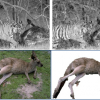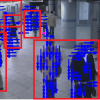107
Voted
ICCV
2009
IEEE
16 years 5 months ago
2009
IEEE
Subspace segmentation is the task of segmenting data
lying on multiple linear subspaces. Its applications in
computer vision include motion segmentation in video,
structure-from...
148
click to vote
ICCV
2009
IEEE
16 years 5 months ago
2009
IEEE
We present a novel multi-view stereo method designed
for image-based rendering that generates piecewise planar
depth maps from an unordered collection of photographs.
First a di...
105
click to vote
ICCV
2009
IEEE
16 years 5 months ago
2009
IEEE
We use concepts from chaos theory in order to model
nonlinear dynamical systems that exhibit deterministic behavior.
Observed time series from such a system can be embedded
into...
105
Voted
ICCV
2009
IEEE
16 years 5 months ago
2009
IEEE
Multilinear algebra is a powerful theoretical tool for visual
geometry, but widespread usage of traditional typographical
notation often hides its conceptual elegance and
simpli...
ICCV
2009
IEEE
16 years 5 months ago
2009
IEEE
We present a wide-baseline image matching approach
based on line segments. Line segments are clustered into
local groups according to spatial proximity. Each group is
treated as...
ICCV
2009
IEEE
16 years 5 months ago
2009
IEEE
We address the classic problems of detection, segmenta-
tion and pose estimation of people in images with a novel
definition of a part, a poselet. We postulate two criteria
(1) ...
ICCV
2009
IEEE
16 years 5 months ago
2009
IEEE
Low-rank approximation of image collections (e.g., via
PCA) is a popular tool in many areas of computer vision.
Yet, surprisingly little is known justifying the observation
that...
ICCV
2009
IEEE
16 years 5 months ago
2009
IEEE
Visual categorization problems, such as object classification or action recognition,
are increasingly often approached using a detection strategy: a classifier function
is first ...
113
click to vote
ICCV
2009
IEEE
16 years 5 months ago
2009
IEEE
In recent years the Markov Random Field (MRF) has
become the de facto probabilistic model for low-level vision
applications. However, in a maximum a posteriori
(MAP) framework, ...
189
click to vote
ICCV
2009
IEEE
16 years 5 months ago
2009
IEEE
This paper addresses the problem of fully automated
mining of public space video data. A novel Markov Clustering
Topic Model (MCTM) is introduced which builds on
existing Dynami...


